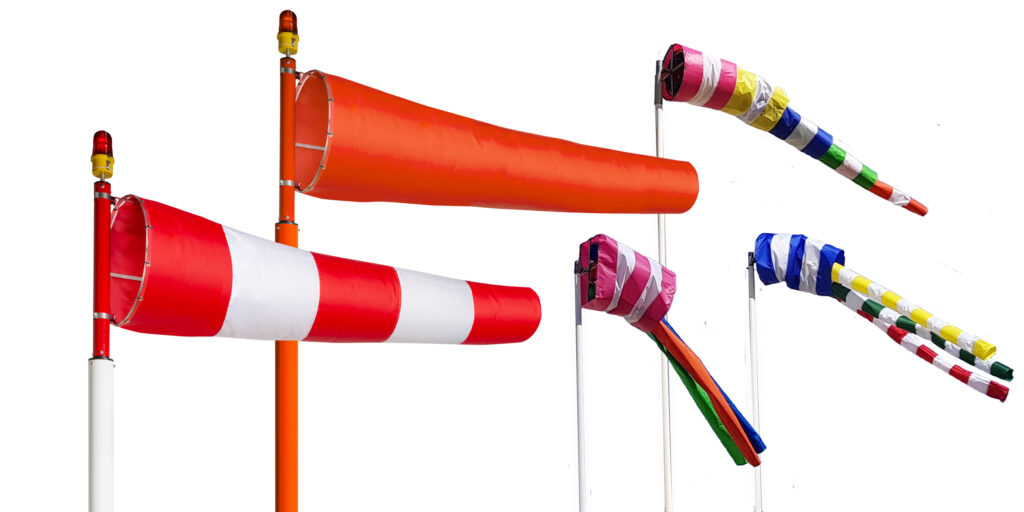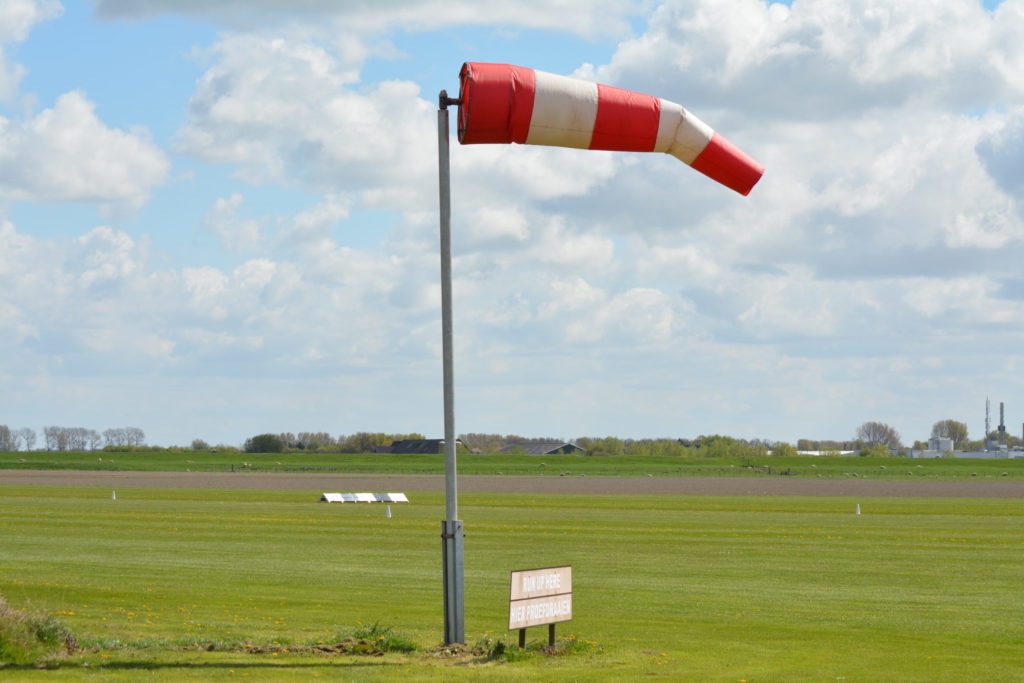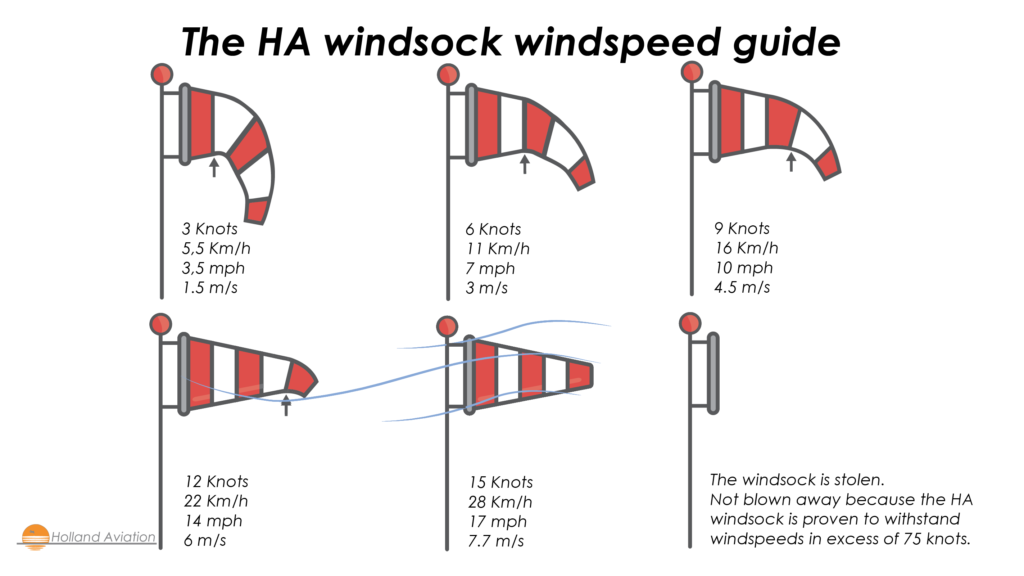What is a windsock?
A windsock is a conically shaped tube made of woven textile, designed for indicating wind direction and speed. Typically suspended or mounted on a metal mast secured to a foundation capable of withstanding high wind speeds, the windsock is affixed to a metal basket that can horizontally rotate 360 degrees, contingent on the prevailing wind direction. These instruments find extensive application at airports, aiding pilots in determining wind conditions before takeoff. Moreover, they are utilized in industrial settings to alert workers to potential hazards, particularly in emergency situations involving hazardous materials.

How is a windsock installed?
Windsocks are affixed to a specialized installation, typically comprising a metal mast crafted from materials such as aluminum or galvanized steel. This mast is firmly positioned on a metal foundation to endure high wind speeds. Atop the mast, a metal basket, also known as a swivel frame, is installed, capable of horizontal rotation spanning 360 degrees. The windsock is connected to this frame, allowing it to move freely in response to the prevailing wind direction.
The complexity of the installation varies based on its intended use. For instance, lighting fixtures may be integrated into the setup for nighttime visibility. Additionally, the mast might be designed to be tiltable, facilitating easier replacement of the windsock.

What is the purpose of a windsock?
Windsocks serve diverse purposes across various industries. Their primary objective is to provide quick indications to personnel or observers regarding the wind direction and intensity. Most commonly, they are positioned near runways or helipads at airports, enabling pilots to promptly assess wind conditions before takeoff.
Moreover, windsocks find application in factories or industrial areas where the release of hazardous gases or substances is a concern. In emergency situations, individuals can swiftly determine the direction in which the hazardous substances are being carried by the wind, aiding them in identifying the most effective escape route. In addition, windsocks are also commonly found on roads and bridges where crosswinds can pose a danger. This informs traffic about wind conditions. And allows drivers to adjust their driving style accordingly in advance.
How does a windsock work?
- The windsock is a tapered, fabric tube mounted on a pole and swivels freely.
- When the wind blows, the narrow end of the windsock points in the direction the wind is going, while the wider, open end faces the wind. This allows you to see the direction of the wind easily.
- The windsock inflates and expands as air flows through it. The stronger the wind, the farther the windsock extends horizontally.
- During light winds, the windsock hangs down partially. As the wind speed increases, it extends outward more, and in very strong winds, it will be almost fully horizontal.
- Some windsocks have stripes that can help estimate the wind speed based on how much the windsock is extended.
What does the color of a windsock mean?
- Bright colors: Windsocks are often made in bright colors like orange, red, or yellow to make sure that they are easy to see against natural backgrounds such as the sky or landscape.
- Striped windsocks: Some windsocks feature alternating stripes of different colors (often red and white). These stripes can help improve visibility and allow for better wind speed estimation by marking sections of the windsock.
- Aviation: In airports and airfields, windsocks are typically bright orange or red for maximum visibility.
- Industrial or hazardous zones: In certain industrial areas or hazardous locations, brightly colored windsocks may indicate areas where wind direction is critical for safety, such as chemical plants, to avoid exposure to harmful gases.
- Medical helicopter landing zones: In some cases, medical helicopter landing areas may use windsocks in specific colors for easy identification.
Are our windsocks calibrated?
Windsocks are calibrated. Brand new windsocks are produced following the guidelines of the ICAO (International Civil Aviation Organization), FAA (Federal Aviation Administration), and EASA (European Union Aviation Safety Agency). This ensures that all current models are calibrated to be fully inflated at wind speeds of 15 knots or more. These standards help provide accurate and consistent wind readings, which are critical for aviation safety and other industries that rely on wind direction and speed information.
What do the windsock speed charts represent?
The selection of stripes on a windsock isn’t solely based on visibility from a considerable distance. When a stripe is “inflated” by the wind, it serves as a gauge for determining the current wind speed.
- 3 knots
- 6 knots
- 9 knots
- 12 knots
- 15 knots or more

What is the lifespan?
Our windsocks are designed for outdoor use and are exposed to wind and weather. We provide high-quality products, and the typical lifespan of these items is about one year under normal conditions. You can certainly leave them hanging for a longer period, but doing so increases the risk of color fading.
Where can you buy a windsock?
For the optimal purchase of a windsock or a complete installation, it is advisable to turn to an international specialist. Holland Aviation, for instance, specializes in the manufacturing and global delivery of windsocks and installations. This ensures that you consistently receive a high-quality product produced in compliance with standard rules and regulations. Explore our range of windbags to discover a windsock that suits your specific requirements.
By now, you should have gained substantial expertise in windsocks! Should you still have any questions, feel free to reach out to one of our experts. Contact us, and we’ll be delighted to assist you on your journey!
